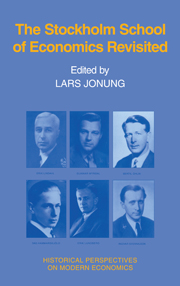Book contents
- Frontmatter
- Dedication
- Contents
- Preface
- List of Contributors
- Dramatis Personae at the end of 1937
- Introduction and Summary
- Part I The roots
- Part II The approach of the Stockholm School
- 4 Expectation and plan: The microeconomics of the Stockholm School
- 5 Sequence analysis and optimization
- 6 There were two Stockholm Schools
- 7 On formal dynamics: From Lundberg to chaos analysis
- 8 Lundberg, Keynes, and the riddles of a general theory
- 9 Macrodynamics and the Stockholm School
- 10 Ohlin and the General Theory
- 11 The monetary economics of the Stockholm School
- 12 The Austrians and the Stockholm School: Two failures in the development of modern macroeconomics?
- 13 The political arithmetics of the Stockholm School
- 14 After the Stockholm School
- Part III The impact of the Stockholm School
- Part IV What remains of the Stockholm School?
- The Stockholm School: A non-Swedish bibliography
6 - There were two Stockholm Schools
Published online by Cambridge University Press: 05 July 2013
- Frontmatter
- Dedication
- Contents
- Preface
- List of Contributors
- Dramatis Personae at the end of 1937
- Introduction and Summary
- Part I The roots
- Part II The approach of the Stockholm School
- 4 Expectation and plan: The microeconomics of the Stockholm School
- 5 Sequence analysis and optimization
- 6 There were two Stockholm Schools
- 7 On formal dynamics: From Lundberg to chaos analysis
- 8 Lundberg, Keynes, and the riddles of a general theory
- 9 Macrodynamics and the Stockholm School
- 10 Ohlin and the General Theory
- 11 The monetary economics of the Stockholm School
- 12 The Austrians and the Stockholm School: Two failures in the development of modern macroeconomics?
- 13 The political arithmetics of the Stockholm School
- 14 After the Stockholm School
- Part III The impact of the Stockholm School
- Part IV What remains of the Stockholm School?
- The Stockholm School: A non-Swedish bibliography
Summary
There may be some difficulties in defining exactly what constitutes the contribution of the collection of writings Bertil Ohlin christened the “Stockholm School” in his 1937 Economic Journal articles (Ohlin, 1937). However, all agree that it consists of the development of macroeconomic analysis carried out by, in particular, Erik Lindahl, Gunnar Myrdal, Erik Lundberg, and Bertil Ohlin himself. Most economists agree that this development, even if somewhat incomplete, was important; and practically everyone seems to be of the opinion that it constitutes the crowning achievement of a generation of Swedish economists. But then it seems forgotten that some of the most prominent members of the School had already made another significant contribution in a quite different field of economics: price theory and general-equilibrium analysis. In my opinion, what has been called the Stockholm School should properly be called the “Second Stockholm School,” in contradistinction to the “First Stockholm School” – even if the lists of members overlap to a large extent. It could easily be argued that the achievements of the First School rank higher. Why, then, is hardly any attention paid to the First School? My answer is simple: mainly because the members themselves wanted it that way.
The two most important, or at least most characteristic, works of the First School are Erik Lindahl's long and elaborate article “The Place of Capital in the Theory of Price” (Swedish original 1929, in English 1939) and Bertil Ohlin's book Interregional and International Trade (1933), preceded by his dissertation with essentially the same message (Ohlin, 1924).
- Type
- Chapter
- Information
- The Stockholm School of Economics Revisited , pp. 177 - 184Publisher: Cambridge University PressPrint publication year: 1991
- 2
- Cited by

